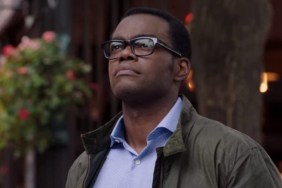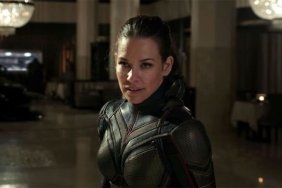
10 Directors Who ALMOST Made Superhero Movies
Many fans were shocked when filmmaker Edgar Wright (Scott Pilgrim vs the World) departed Marvel’s Ant-Man weeks before principal photography after developing the project for eight years, fearing that the final product would be marred without Wright’s input. Luckily, replacement director Peyton Reed (Bring It On) brought his love of comics and dexterity with comedy to the film, all the while adding many elements that fans enjoyed.
Now that Ant-Man is hitting Blu-ray/DVD this week, interested viewers can watch the movie with Reed and star/co-writer Paul Rudd’s insightful commentary that sheds light on what remained from Wright’s vision (the costume, the heist structure, the rave scene, the tank keychain, the finale in a little girl’s bedroom) and what was added after (Michael Peña tip montages, Baskin Robbins, the Janet van Dyne/Wasp subplot, The Falcon, the quantum realm).
Wright is, of course, not the first filmmaker to decline/lose the opportunity to make big-budget superhero movies — James Cameron’s Spider-Man is one that’s been talked about ad nauseam — so we’re looking at ten filmmakers that came close-but-no-cigar on that front.
Check it out in the gallery below, and hit full screen to read each entry on a desktop.
Be sure to order your copy of Ant-Man by clicking here!
10 Directors Who ALMOST Made a Superhero Movie
-
Wes Craven - Superman IV: The Quest for Peace (1987)

WHO ACTUALLY MADE IT: Sidney J. Furie
Yes, technically horrormeister Wes Craven (Nightmare on Elm Street, Scream) made a sorta superhero movie with a low-budget version of DC's Swamp Thing, although that character is hardly a superhero and the 1982 movie is barely a movie. He got a second shot at the big time when notoriously schlocky '80s production company Cannon Films hired him to make the big-budget Superman IV, but someone stood in his way: a snobby Christopher Reeve. Craven believed that the Juilliard-trained actor felt himself to be above the maker of The Last House on the Left, and told him flat out, "I'm not going to do a film with you." This may have been a blessing in disguise as the resulting movie had its budget carved in half mid-production by Cannon and what was released in theaters would not have been suitable for even a test screening. It harmed a lot of careers, especially Reeve's, and killed the Superman franchise for nearly two decades.
-
Joe Dante – Batman (1989)/The Phantom (1996)

WHO ACTUALLY MADE IT: Tim Burton/ Simon Wincer
A cult hero for making such movies as Gremlins, Innerspace and The 'burbs, Dante got two chances to test his mettle in the comic book genre and ultimately bailed both times. For Batman, he was brought on in the mid-eighties to helm a Tom Mankiewicz-scripted take on the caped crusader, but left because he "didn't really believe in Batman."
"I just couldn't swallow the idea of the guy living up on a Hill, dressing up as a bat...Robin and all that... so I told them I didn't think I was the right guy for the movie," Dante remembers. "They, of course, said 'You must be crazy!', but I seriously believed, and still do, that I wasn't the right choice for the movie. It wasn't the movie that Tim Burton did, it was much more period. I don't regret not taking it on."
Despite turning it down, Dante would make several references to the character in his later films, including a bat symbol in Gremlins 2 and a fictional Batman movie being directed by Roger Corman (!) on the Warners backlot in Looney Tunes: Back in Action.
Another comic hero he almost brought to life was Lee Falk's The Phantom, which he wrote with Jeffrey Boam as a satire of superhero movies. Weeks away from shooting in Australia, Paramount balked at the budget and an expensive winged demon villain, so Dante bailed once again.
"A year or so later it was put back into production - sans demon - only nobody seemed to notice it was written to be funny, so it was – disastrously - played straight," Dante said.
-
Walter Hill – Dick Tracy (1990)

WHO ACTUALLY MADE IT: Warren Beatty
In the '70s and '80s, the go-to director for hard-boiled action was Walter Hill, who had helmed such tough guy flicks as 48 Hours, The Warriors and The Driver. John Landis had commissioned Jim Cash and Jack Epps, Jr. to write a script for a Dick Tracy movie, but it was ultimately Hill who got the gig to direct Warren Beatty as Chester Gould's iconic police detective. Using Cash and Epps' script, Hill got as far as building sets when his vision for a violent, "Untouchables"-esque crime movie chaffed with comic fan Beatty's primary colored, cartoony take on the character. Beatty wound up taking over and making a film that looked like a paint factory blew up in a studio filled with Stephen Sondheim songs, but if that's your thing…
-
Robert Zemeckis – The Shadow (1994)

WHO ACTUALLY MADE IT: Russell Mulcahy
It seems like an adaptation of Walter B. Gibson's pulp crime fighter The Shadow was near and dear to director Robert Zemeckis and his writing partner Bob Gale, but unfortunately became a victim of their incredible success. They planned on making the film for Universal in the early '80s, but the success of Romancing the Stone allowed them to realize their pet project called Back to the Future. Once that film led to Zemeckis making Who Framed Roger Rabbit and Gale penning an (aborted) Dr. Strange movie they had to farm out the Shadow script to Howard Franklin (Quick Change).
"We see 'The Shadow' taking place at night, a benign Dracula terrorizing criminals," Gale told Starlog in 1986. "It's an action-oriented film, taking elements from the radio show and the books."
In the end, it seems the project simply got away from them once they refocused on the Back to the Future sequels, and producer Martin Bregman ultimately went with a David Koepp script helmed to aesthetic faithfulness by Russell Mulcahy (Highlander) that didn't catch on with audiences.
-
Tarsem Singh – Constantine (2005)

WHO ACTUALLY MADE IT: Francis Lawrence
Coming from the world of music videos and commercials, Tarsem made his directorial debut on the visually surreal thriller The Cell, which belied all the hallmarks of someone who could adapt Garth Ennis's "Hellblazer" comics to the screen. Warner Bros. thought so too, and it looked like Nicolas Cage was onboard to star as John Constantine, but then Tarsem abandoned the project. It didn't end there, though, as the studio then sued him for supposedly violating his contract, to which he countersued for violating his rights under the DGA agreement by preventing his input on the script. The studio ultimately found another commercial/music video talent in the form of Francis Lawrence, while Tarsem went on to personally finance The Fall, a personal film and arguably one of the most visually stunning movies of that decade.
-
McG – Superman Returns (2006)

WHO ACTUALLY MADE IT: Bryan Singer
The music video maker who cut his feature teeth on the two Charlie's Angels movies was one of many to be courted by Warners to resurrect the dormant Superman franchise (including Tim Burton and Brett Ratner), but McG is certainly the most tragic of all of them. Real name Joseph McGinty Nichol, he planned to shoot a script by J.J. Abrams titled Superman: Flyby that played with Kal El's Kryptonian origins. At one point, he left the project, was replaced by Ratner, then came back and did a great deal of design work as well as casting, including Robert Downey Jr. as Lex Luthor and Shia LaBeouf as Jimmy Olsen. He even considered future Superman star Henry Cavill as his Man of Steel, but his fear of flying ultimately sidelined him when Warners' insisted that he shoot in the more cost-effective Australia. McG vacated the director's chair and Singer took over.
-
Paul Greengrass – Watchmen (2009)

WHO ACTUALLY MADE IT: Zack Snyder
Although both Terry Gilliam and Darren Aronofsky had been briefly attached at various times to adapt Alan Moore and Dave Gibbons' masterwork (Aronofsky reportedly for a period of only two weeks) neither of them were able to crack it. At one point in the mid-2000's, it looked like producer Larry Gordon had finally found the right man to adapt a graphic novel both Gilliam and Moore himself had deemed "unfilmmable" and that was Paul Greengrass, known for political thrillers like Bloody Sunday and The Bourne Supremacy. When the Brit came aboard he decided to modernize the story from an alternate 1985 to an alternate Bush-era America, politicizing and taking liberties with the design/story to a far greater extent than the film made by Zack Snyder (yes, there would have been shaky cam). Sets were being built and cast rumored to include Joaquin Phoenix (Nite Owl), Paddy Considine (Rorschach), Hilary Swank (Silk Spectre II), Jude Law (Ozymandias) and Ron Perlman (The Comedian). Ultimately a new regime at Paramount thought the project too costly a risk and put it into turnaround after millions had already been spent, although Greengrass has stated he still hopes to someday helm a superhero movie.
-
Darren Aronofsky – The Wolverine (2013)

WHO ACTUALLY MADE IT: James Mangold
In 2010, Fox hired acclaimed filmmaker Darren Aronofsky to make a follow-up to Gavin Hood's poorly-received 2009 spin-off X-Men Origins: Wolverine, with an eye towards A) pleasing star Hugh Jackman, who worked with Aronofsky on The Fountain, and B) lending artistic gravitas to a character that had taken a beating on his last outing. With a script by Christopher McQuarrie based on Frank Miller's Japan-set miniseries from the '80s, Aronofsky re-imagined the story as a one-off existing outside the continuity of the X-Men franchise. After setting up production in New York and Japan, Aronofsky suddenly bailed, citing family reasons.
“As I talked more about the film with my collaborators at Fox, it became clear that the production of ‘The Wolverine’ would keep me out of the country for almost a year," stated Aronofsky. "I was not comfortable being away from my family for that length of time."
While the family story might have truth to it, some have speculated that the surprise success of the director's Black Swan had enabled Aronofsky the clout to make his own passion project Noah as opposed to a studio for-hire gig. Jackman then turned to his Kate & Leopold director Mangold to finish the job.
-
Joe Carnahan – Daredevil (2015)

WHO ACTUALLY MADE IT: Netflix
After Ben Affleck's Daredevil failed to set the world on fire, 20th Century Fox let an inevitable reboot linger until the 11th hour when they hired David Slade (30 Days of Night) to develop a new vision for the character, except he ultimately left the project to direct the "Hannibal" pilot. In the wake of Slade departing, Fox was scrambling to put together a viable film before their rights to the character expired. Enter Joe Carnahan, who had previously worked with the studio on The A-Team. He started formulating plans for a gritty, Scorsese-inspired trilogy that took its tone from the Frank Miller iteration of the character, even creating a sizzle reel with footage from Taxi Driver and The Warriors.
"I suggested a trilogy as follows: ‘Daredevil ‘73’ ‘Daredevil ‘79’ and ‘Daredevil ‘85’ where I was going to do a kind of ‘cultural libretto’ and make the music of those eras a kind of thematic arc," said Carnahan. "So the first one would be Classic Rock, the second one would be Punk Rock and the third film would be ‘New Wave.’"
Ultimately Carnahan couldn't complete his script in time, begging Marvel for an extension which they did not grant, and the rights ultimately reverted back to the company, resulting in the acclaimed Netflix series which also took a more gritty (if modern) approach.
-
Michelle MacLaren – Wonder Woman (2017)

WHO ACTUALLY MADE IT: Patty Jenkins
Michelle MacLaren is considered in most circles to be one of the best TV helmers in the biz, directing choice episodes of hit shows like "Game of Thrones," "The Walking Dead" and "Breaking Bad," winning back-to-back Emmy's for the latter. When Warner Bros. hired her in late 2014 to make the Wonder Woman solo movie for the DC Extended Universe, it was greeted by both fans and the industry as a bold move, as she would become the first female to direct a big-budget tentpole superhero movie. However, after six months on the project MacLaren departed due to the age-old "creative differences" excuse. Industry scuttlebutt said that MacLaren envisioned a sprawling Braveheart-like historical epic, while the studio wanted something smaller and more character-oriented, wary of a first-time feature director taking on something too massive. Ironically (or perhaps even intentionally) Warners wound up hiring Patty Jenkins, also a TV vet albeit one with experience in feature directing with 2003's acclaimed serial killer drama Monster, who was originally hired by Marvel Studios to make Thor: The Dark World before being let go in a manner similar to MacLaren.



